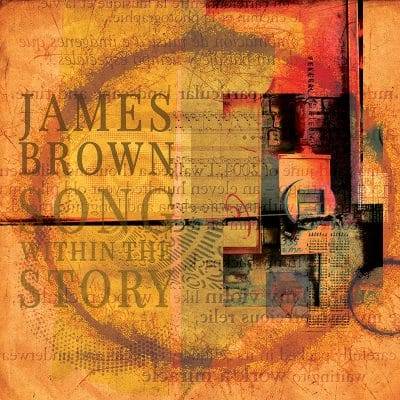James Brown Song Within the Story
 James Brown
James Brown
Song Within the Story
NGP
With the most familiar of names, Canadian jazz guitarist James Brown is likely not familiar to those who are now reading this. Song Within the Story is his first album in more than a decade to boot. It’s primarily a trio recording, featuring bassist Clark Johnston, and drummer Anthony Michelli, with guest tenorist Mike Murley on three tracks. The trio hails from Toronto along with Murley, a top improviser, who has appeared on 14 Juno-winning recordings over the past three decades (seven as a leader or co-leader and seven as a sideman). This is a fusion album, but not of the jazz-rock variety although at times, it bears those qualities. Brown has built his reputation on marrying jazz and classical music, to the point of writing his master’s thesis on the Third Stream movement (the early ‘60s movement to merge the two genres). Some of that inevitably comes across on these eight originals but the music swings too, as Brown’s rhythm mates push him from melodic lines into inventive, often ferocious improvisations with rich, loud, reverberating effects. They also deliver unique interpretations of Canadian folk-rock classics: Neil Young’s “The Needle and the Damage Done” and Joni Mitchell’s “A Case of You.”
The full tone of Brown’s guitar, Johnston’s robust bass, and especially MIchelli’s intricate, driving and remarkably tasteful work on the kit make for sound that sets itself clearly apart from most jazz guitar trios. Although the music is often intricate and complex, the musicians deliver it accessibly with a polished interplay that could only come from frequent gigging over the past three or four years in their home city.
They open with “Igor,” a tribute to one of Brown’s favorite composers, Stravinsky. The backbone of the piece is the bass figure from Soldier’s March in the composer’s “L Histoire du soldat,” which evolves in a blistering minor blues before returning to the heavy, rather daunting theme. “Alystair and I” is a syncopated shuffle in 7/4 time dedicated to Brown’s son. Not only does this offer hints of Bill Frisell’s thoughtful, folk-oriented approach but Michelli’s throbbing, pulsing drumming is simply stunning here.
The major takeaway from the title track is the harmonic effect of Brown’s guitar and Murley’s tenor to create an edgy, contemplative, but disarming feel. Brown reimagined this piece from the opening movement of his chamber work, “The Mosley Street Suite,” originally a vocal setting of the T. S. Eliot poem “The Hollow Men,” thus the tonality. This track is hardly jazz-classical but instead bears more elements of jazz-fusion or even rock with echoes of Pat Metheny. Brown says, “I’ve always liked Pat Metheny and Steve Swallow and that ECM style of writing. I’m not afraid of going into folk or rock. I like when there’s something a little bit more going on.”
“Nice Folk” retreats into more flowing melodic lines, with a lyrical solo spot from bassist Johnston and more impressive skittering kit work from Michelli. The harmonically and rhythmically complex sing-song theme of “The Circle” follows, yet another example of telepathic trio interplay. “Sands of Swing” also brings rhythmic challenges that the trio and the returning Murley deftly navigate as Brown and the saxophonist trade solos and refract off each other in a way that evokes the ECM imprint of Keith Jarrret’s European Quartet. The more delicate “All Rivers Lead” is marked by riveting guitar-sax interplay and Murley’s solo which draws a superb balance between thoughtful exploration and burning intensity. “Mbira’s Kids,” based on rhythmic figures used in sacred Shona music from Zimbabwe, is the most radio friendly of the tunes. It’s the fourth and concluding movement from “The Mosley Street Suite” and has Brown in a spiritual mode with his spiraling, distortion-laden solo
The two covers honor the two most notable Canadian artists of the folk-rock era, Neil Young and Joni Mitchell. These imaginative interpretations first render Young’s “The Needle and the Damage Done” into dirge-like, deeply solemn territory beyond that envisioned by the original composer, later spiked by blistering axe work. On the other hand, they take Mitchell’s “A Case of You” more faithfully with Johnston introducing the melody on the bass. The tune serves as a nice album closer, like the after-dinner cordial that just puts the cap on a flavorful meal.
This is one of the best jazz guitar albums this writer, who fervently listens to greats like Frisell, Bernstein, and Metheny, has heard in recent memory. It can easily stand with the best from those giants.
- Jim Hynes
Buy Us a Cup of Coffee!
Join the movement in supporting Making a Scene, the premier independent resource for both emerging musicians and the dedicated fans who champion them.
We showcase this vibrant community that celebrates the raw talent and creative spirit driving the music industry forward. From insightful articles and in-depth interviews to exclusive content and insider tips, Making a Scene empowers artists to thrive and fans to discover their next favorite sound.
Together, let’s amplify the voices of independent musicians and forge unforgettable connections through the power of music
Make a one-time donation
Make a monthly donation
Make a yearly donation
Buy us a cup of Coffee!
Or enter a custom amount
Your contribution is appreciated.
Your contribution is appreciated.
Your contribution is appreciated.
DonateDonate monthlyDonate yearlyYou can donate directly through Paypal!
Subscribe to Our Newsletter
Discover more from Making A Scene!
Subscribe to get the latest posts sent to your email.













































